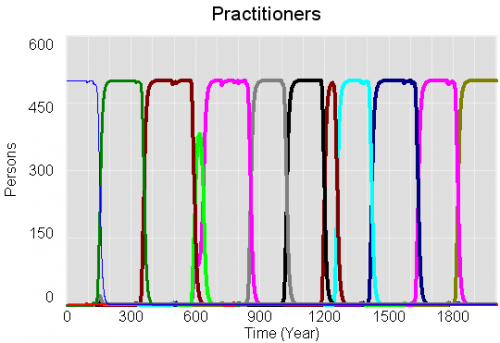This is a very interesting model, both because it tackles ‘soft’ dynamics of paradigm formation in ‘hard’ science, and because it is an aggregate approach to an agent problem. Unfortunately, until now, the model was only available in DYNAMO, which limited access severely. It turns out to be fairly easy to translate to Vensim using the dyn2ven utility, once you know how to map the DYNAMO array FOR loops to Vensim subscripts.
Path Dependence, Competition, and Succession in the Dynamics of Scientific Revolution
J. Wittenberg and J. D. Sterman, 1999
Abstract
What is the relative importance of structural versus contextual forces in the birth and death of scientific theories? We describe a dynamic model of the birth, evolution, and death of scientific paradigms based on Kuhn’s Structure of Scientific Revolutions. The model creates a simulated ecology of interacting paradigms in which the creation of new theories is stochastic and endogenous. The model captures the sociological dynamics of paradigms as they compete against one another for members. Puzzle solving and anomaly recognition are also endogenous. We specify various regression models to examine the role of intrinsic versus contextual factors in determining paradigm success. We find that situational factors attending the birth of a paradigm largely determine its probability of rising to dominance, while the intrinsic explanatory power of a paradigm is only weakly related to the likelihood of success. For those paradigms that do survive the emergence phase, greater explanatory power is significantly related to longevity. However, the relationship between a paradigm’s ‘strength’ and the duration of normal science is also contingent on the competitive environment during the emergence phase. Analysis of the model shows the dynamics of competition and succession among paradigms to be conditioned by many positive feedback loops. These self-reinforcing processes amplify intrinsically unobservable micro-level perturbations in the environment – the local conditions of science, society, and self faced by the creators of a new theory – until they reach macroscopic significance. Such dynamics are the hallmark of self-organizing evolutionary systems.
We consider the implications of these results for the rise and fall of new ideas in contexts outside the natural sciences such as management fads.
Cite as: J. Wittenberg and J. D. Sterman (1999) Path Dependence, Competition, and Succession in the Dynamics of Scientific Revolution. Organization Science, 10.
I believe that this version is faithful to the original, but it’s difficult to be sure because the model is stochastic, so the results differ due to differences in the random number streams. For the moment, this model should be regarded as a beta release.

A few manual changes were made to the model, following the dyn2ven translation:
- Non-working subscript expressions were fixed.
- A few units errors in the original were corrected.
- A few minor changes were made to eliminate division-by-zero issues with use of NOSNDP. These caused floating point errors in the initial translation. I believe that the issue is that division by zero occurs when NOSNDP (number of strongest non-dominant paradigms) falls to 0. In DYNAMO, these errors may have been tolerated by the compiler because they only occurred when the numerator was also 0, resulting in a 0/0 condition. If that is the case, then this version should be behaviorally faithful to the original. If not, there may be some other cause of the error.
Manual edits of possible significance are tagged with a !! (double exclamation point) in the comment field, so that they’re easy to find in the text listing.
Two further improvements would be much appreciated by future users, spreading your fame around the modeling world:
- Completion of the model’s stock-flow diagrams. This is fairly easy if you break the stocks up into separate views and use the Model Variable sketch tool to convert shadow variables to full variables (stopping as appropriate to preserve sector boundaries).
- Creating full variable names. For easy search and comparison with the DYNAMO listing and other resources, it’s best to preserve the existing short names as prefixes, e.g., “PUA” becomes “PUA puzzles under attack.”
If you do create an upgraded version, add your name to the About screen and send me a copy so I can update this post. To avoid duplication of effort, you might let others know what you’re up to in the comments below.
For Vensim Pro or DSS: scirev7.mdl
DSS, Pro or Model Reader: scirev7.vpm
You can find the original DYNAMO code and article here.
Update:
This new version has real variable names and vastly improved diagrams:
For Vensim Pro or DSS: scirev8.mdl
DSS, Pro or Model Reader: scirev8.vpm

Hi
I ‘ve tried to open the model with vensim reader but it won’t work.
in Vensim PLE there is some structure visible which crosschecking with the documented equations is a fraction of the total. I am trying to translate it to powersim. any chance of opening a version of the model with either the reader or PLE so that i can see the structure and follow the equations?
thanks
I added the .vpm version, which should work with the reader. I haven’t had a chance to test it, so let me know if there are any issues. If you get a working PowerSim version, I’ll host it here if it’s of interest. The arrays for this model are fairly simple, so translation should be possible.
The model won’t run in PLE due to the use of arrays.
The diagram currently reflects only a portion of the actual structure; the full structure can be viewed by causal tracing, in the text editor view, or with the Document tool.